An Examination of Religious Beliefs and Support for Capital Punishment
VerifiedAdded on 2023/06/03
|8
|1609
|482
Report
AI Summary
This report examines the relationship between religious beliefs and support for the death penalty, using data from the 2015 British Social Attitudes (BSA) report. The study investigates how religious orientation, including faith in a religion and images of judgment and suffering, influences attitudes toward capital punishment. The report includes an abstract, introduction, literature review, research methodology, findings, discussion, limitations, and conclusion. The methodology involves a multi-stage sampling structure with interviews conducted across the UK. Key findings suggest a correlation between religious adherence and support for the death penalty, particularly when religious beliefs emphasize judgment and punishment. The report also acknowledges limitations and suggests avenues for future research, emphasizing the importance of considering religious images when studying the death penalty and criminal justice.
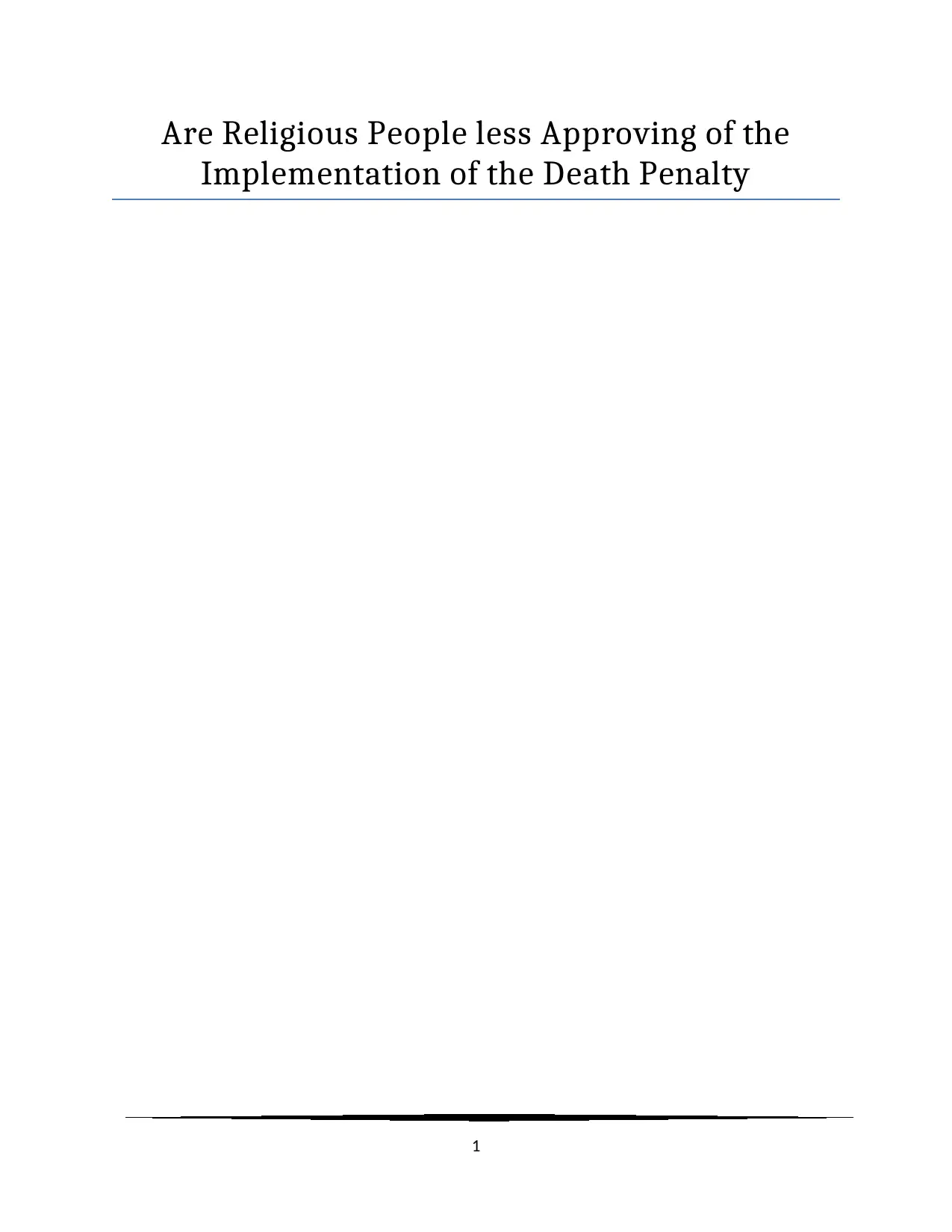
Are Religious People less Approving of the
Implementation of the Death Penalty
1
Implementation of the Death Penalty
1
Paraphrase This Document
Need a fresh take? Get an instant paraphrase of this document with our AI Paraphraser
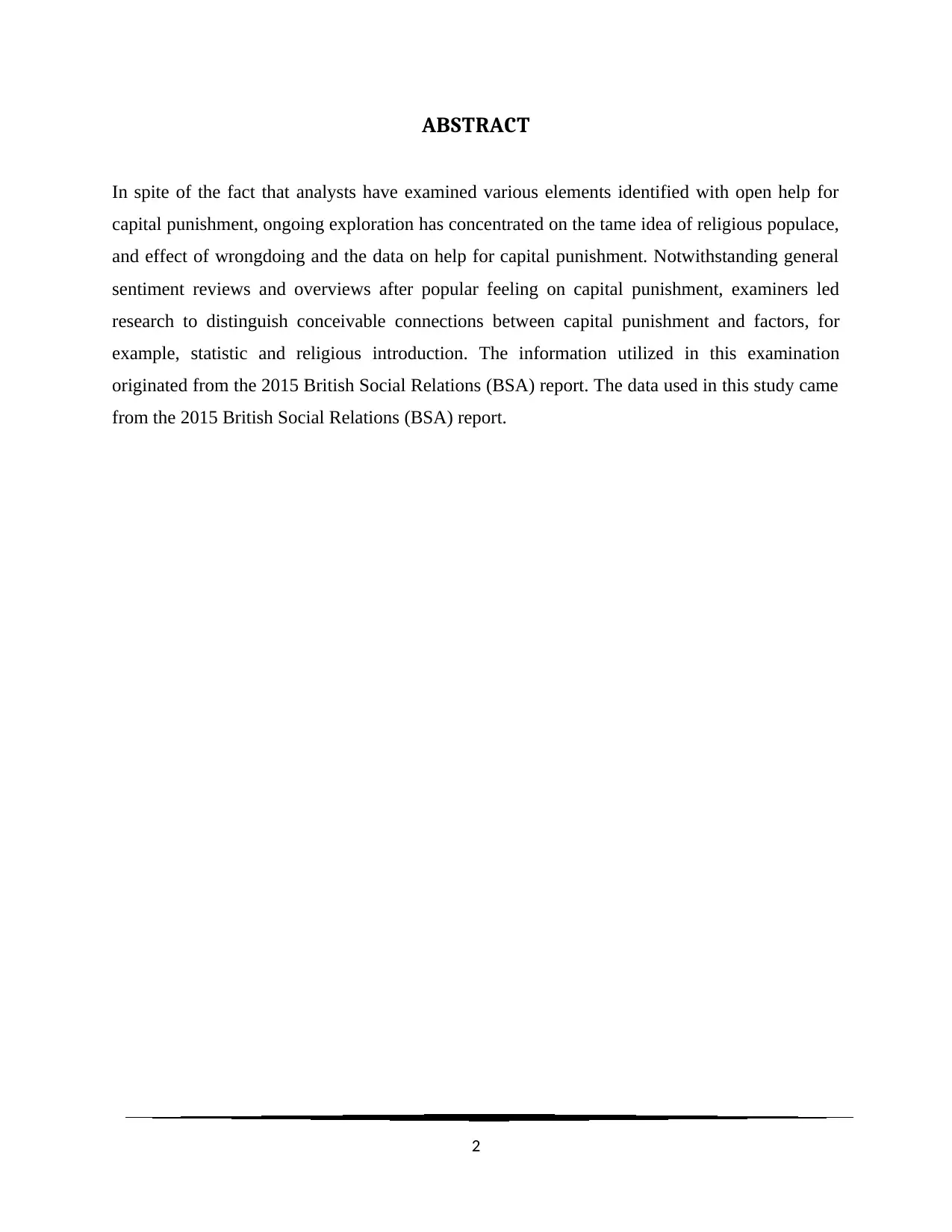
ABSTRACT
In spite of the fact that analysts have examined various elements identified with open help for
capital punishment, ongoing exploration has concentrated on the tame idea of religious populace,
and effect of wrongdoing and the data on help for capital punishment. Notwithstanding general
sentiment reviews and overviews after popular feeling on capital punishment, examiners led
research to distinguish conceivable connections between capital punishment and factors, for
example, statistic and religious introduction. The information utilized in this examination
originated from the 2015 British Social Relations (BSA) report. The data used in this study came
from the 2015 British Social Relations (BSA) report.
2
In spite of the fact that analysts have examined various elements identified with open help for
capital punishment, ongoing exploration has concentrated on the tame idea of religious populace,
and effect of wrongdoing and the data on help for capital punishment. Notwithstanding general
sentiment reviews and overviews after popular feeling on capital punishment, examiners led
research to distinguish conceivable connections between capital punishment and factors, for
example, statistic and religious introduction. The information utilized in this examination
originated from the 2015 British Social Relations (BSA) report. The data used in this study came
from the 2015 British Social Relations (BSA) report.
2
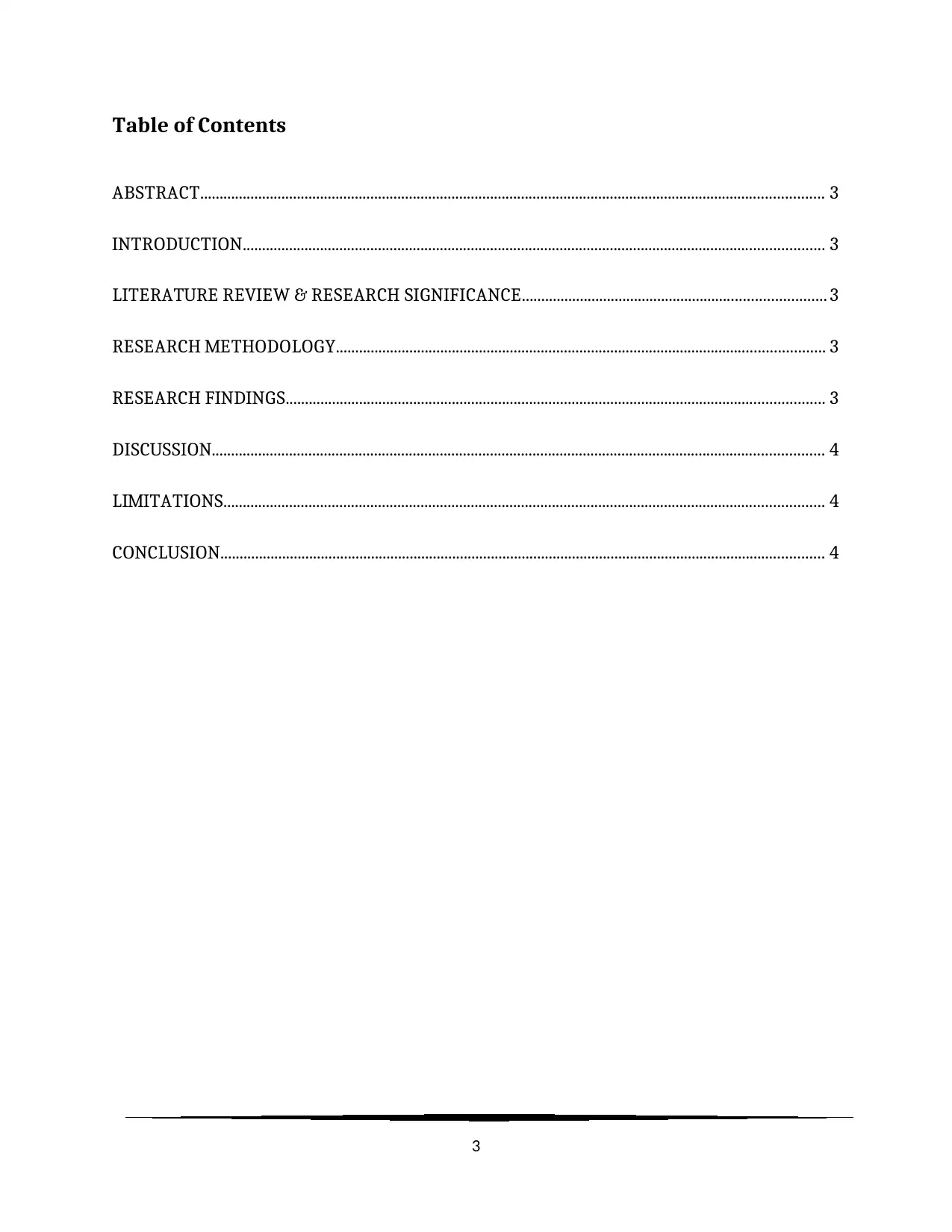
Table of Contents
ABSTRACT................................................................................................................................................................. 3
INTRODUCTION...................................................................................................................................................... 3
LITERATURE REVIEW & RESEARCH SIGNIFICANCE..............................................................................3
RESEARCH METHODOLOGY.............................................................................................................................. 3
RESEARCH FINDINGS........................................................................................................................................... 3
DISCUSSION.............................................................................................................................................................. 4
LIMITATIONS........................................................................................................................................................... 4
CONCLUSION............................................................................................................................................................ 4
3
ABSTRACT................................................................................................................................................................. 3
INTRODUCTION...................................................................................................................................................... 3
LITERATURE REVIEW & RESEARCH SIGNIFICANCE..............................................................................3
RESEARCH METHODOLOGY.............................................................................................................................. 3
RESEARCH FINDINGS........................................................................................................................................... 3
DISCUSSION.............................................................................................................................................................. 4
LIMITATIONS........................................................................................................................................................... 4
CONCLUSION............................................................................................................................................................ 4
3
⊘ This is a preview!⊘
Do you want full access?
Subscribe today to unlock all pages.

Trusted by 1+ million students worldwide
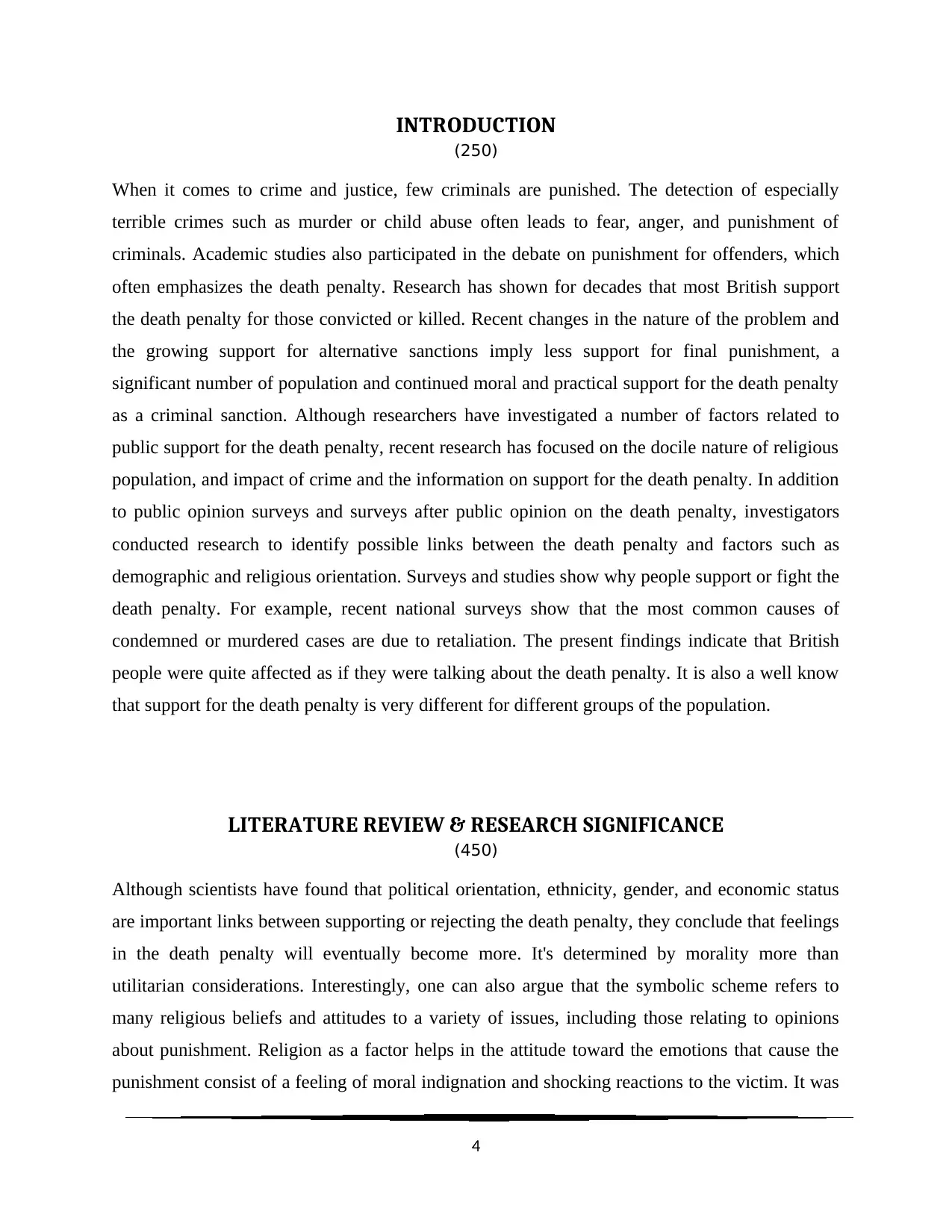
INTRODUCTION
(250)
When it comes to crime and justice, few criminals are punished. The detection of especially
terrible crimes such as murder or child abuse often leads to fear, anger, and punishment of
criminals. Academic studies also participated in the debate on punishment for offenders, which
often emphasizes the death penalty. Research has shown for decades that most British support
the death penalty for those convicted or killed. Recent changes in the nature of the problem and
the growing support for alternative sanctions imply less support for final punishment, a
significant number of population and continued moral and practical support for the death penalty
as a criminal sanction. Although researchers have investigated a number of factors related to
public support for the death penalty, recent research has focused on the docile nature of religious
population, and impact of crime and the information on support for the death penalty. In addition
to public opinion surveys and surveys after public opinion on the death penalty, investigators
conducted research to identify possible links between the death penalty and factors such as
demographic and religious orientation. Surveys and studies show why people support or fight the
death penalty. For example, recent national surveys show that the most common causes of
condemned or murdered cases are due to retaliation. The present findings indicate that British
people were quite affected as if they were talking about the death penalty. It is also a well know
that support for the death penalty is very different for different groups of the population.
LITERATURE REVIEW & RESEARCH SIGNIFICANCE
(450)
Although scientists have found that political orientation, ethnicity, gender, and economic status
are important links between supporting or rejecting the death penalty, they conclude that feelings
in the death penalty will eventually become more. It's determined by morality more than
utilitarian considerations. Interestingly, one can also argue that the symbolic scheme refers to
many religious beliefs and attitudes to a variety of issues, including those relating to opinions
about punishment. Religion as a factor helps in the attitude toward the emotions that cause the
punishment consist of a feeling of moral indignation and shocking reactions to the victim. It was
4
(250)
When it comes to crime and justice, few criminals are punished. The detection of especially
terrible crimes such as murder or child abuse often leads to fear, anger, and punishment of
criminals. Academic studies also participated in the debate on punishment for offenders, which
often emphasizes the death penalty. Research has shown for decades that most British support
the death penalty for those convicted or killed. Recent changes in the nature of the problem and
the growing support for alternative sanctions imply less support for final punishment, a
significant number of population and continued moral and practical support for the death penalty
as a criminal sanction. Although researchers have investigated a number of factors related to
public support for the death penalty, recent research has focused on the docile nature of religious
population, and impact of crime and the information on support for the death penalty. In addition
to public opinion surveys and surveys after public opinion on the death penalty, investigators
conducted research to identify possible links between the death penalty and factors such as
demographic and religious orientation. Surveys and studies show why people support or fight the
death penalty. For example, recent national surveys show that the most common causes of
condemned or murdered cases are due to retaliation. The present findings indicate that British
people were quite affected as if they were talking about the death penalty. It is also a well know
that support for the death penalty is very different for different groups of the population.
LITERATURE REVIEW & RESEARCH SIGNIFICANCE
(450)
Although scientists have found that political orientation, ethnicity, gender, and economic status
are important links between supporting or rejecting the death penalty, they conclude that feelings
in the death penalty will eventually become more. It's determined by morality more than
utilitarian considerations. Interestingly, one can also argue that the symbolic scheme refers to
many religious beliefs and attitudes to a variety of issues, including those relating to opinions
about punishment. Religion as a factor helps in the attitude toward the emotions that cause the
punishment consist of a feeling of moral indignation and shocking reactions to the victim. It was
4
Paraphrase This Document
Need a fresh take? Get an instant paraphrase of this document with our AI Paraphraser
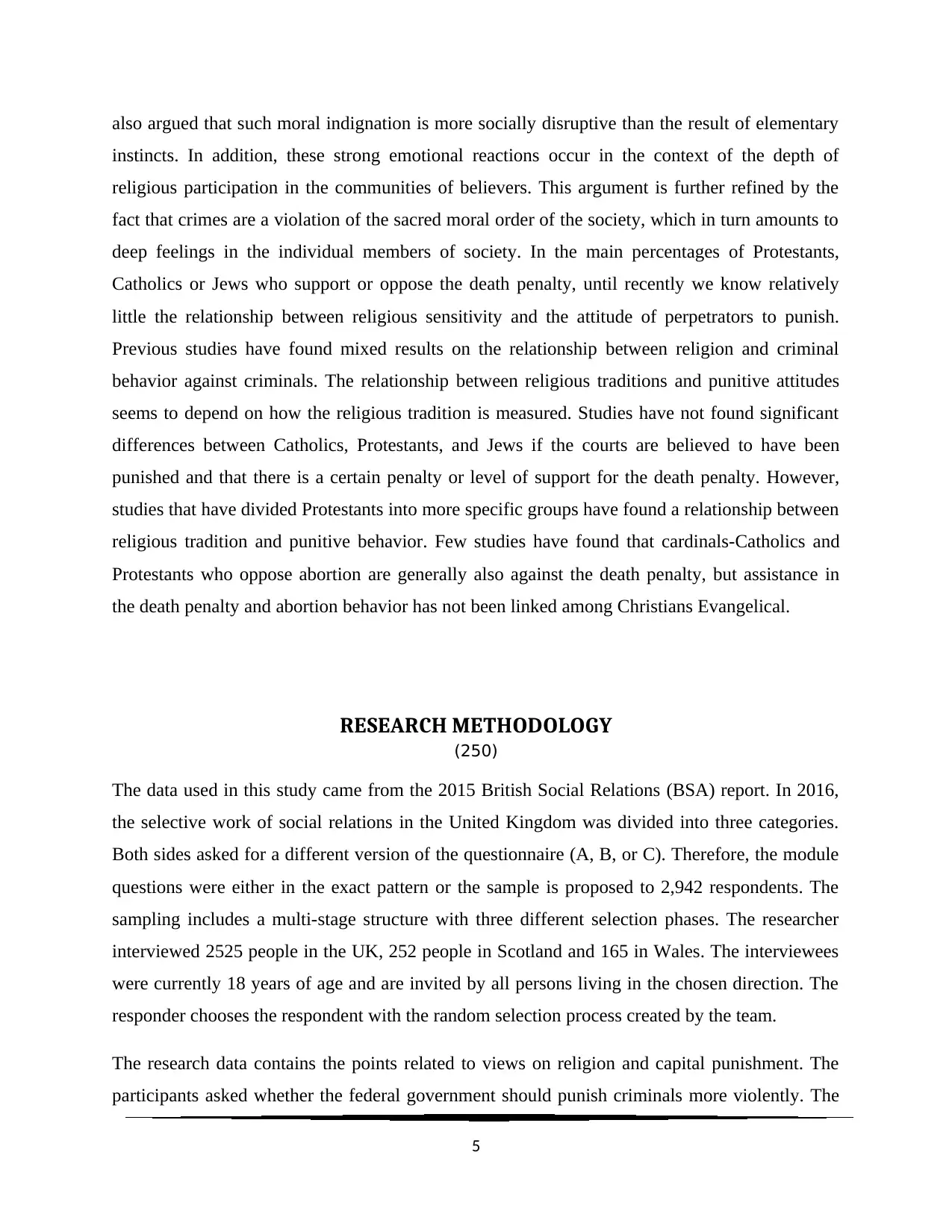
also argued that such moral indignation is more socially disruptive than the result of elementary
instincts. In addition, these strong emotional reactions occur in the context of the depth of
religious participation in the communities of believers. This argument is further refined by the
fact that crimes are a violation of the sacred moral order of the society, which in turn amounts to
deep feelings in the individual members of society. In the main percentages of Protestants,
Catholics or Jews who support or oppose the death penalty, until recently we know relatively
little the relationship between religious sensitivity and the attitude of perpetrators to punish.
Previous studies have found mixed results on the relationship between religion and criminal
behavior against criminals. The relationship between religious traditions and punitive attitudes
seems to depend on how the religious tradition is measured. Studies have not found significant
differences between Catholics, Protestants, and Jews if the courts are believed to have been
punished and that there is a certain penalty or level of support for the death penalty. However,
studies that have divided Protestants into more specific groups have found a relationship between
religious tradition and punitive behavior. Few studies have found that cardinals-Catholics and
Protestants who oppose abortion are generally also against the death penalty, but assistance in
the death penalty and abortion behavior has not been linked among Christians Evangelical.
RESEARCH METHODOLOGY
(250)
The data used in this study came from the 2015 British Social Relations (BSA) report. In 2016,
the selective work of social relations in the United Kingdom was divided into three categories.
Both sides asked for a different version of the questionnaire (A, B, or C). Therefore, the module
questions were either in the exact pattern or the sample is proposed to 2,942 respondents. The
sampling includes a multi-stage structure with three different selection phases. The researcher
interviewed 2525 people in the UK, 252 people in Scotland and 165 in Wales. The interviewees
were currently 18 years of age and are invited by all persons living in the chosen direction. The
responder chooses the respondent with the random selection process created by the team.
The research data contains the points related to views on religion and capital punishment. The
participants asked whether the federal government should punish criminals more violently. The
5
instincts. In addition, these strong emotional reactions occur in the context of the depth of
religious participation in the communities of believers. This argument is further refined by the
fact that crimes are a violation of the sacred moral order of the society, which in turn amounts to
deep feelings in the individual members of society. In the main percentages of Protestants,
Catholics or Jews who support or oppose the death penalty, until recently we know relatively
little the relationship between religious sensitivity and the attitude of perpetrators to punish.
Previous studies have found mixed results on the relationship between religion and criminal
behavior against criminals. The relationship between religious traditions and punitive attitudes
seems to depend on how the religious tradition is measured. Studies have not found significant
differences between Catholics, Protestants, and Jews if the courts are believed to have been
punished and that there is a certain penalty or level of support for the death penalty. However,
studies that have divided Protestants into more specific groups have found a relationship between
religious tradition and punitive behavior. Few studies have found that cardinals-Catholics and
Protestants who oppose abortion are generally also against the death penalty, but assistance in
the death penalty and abortion behavior has not been linked among Christians Evangelical.
RESEARCH METHODOLOGY
(250)
The data used in this study came from the 2015 British Social Relations (BSA) report. In 2016,
the selective work of social relations in the United Kingdom was divided into three categories.
Both sides asked for a different version of the questionnaire (A, B, or C). Therefore, the module
questions were either in the exact pattern or the sample is proposed to 2,942 respondents. The
sampling includes a multi-stage structure with three different selection phases. The researcher
interviewed 2525 people in the UK, 252 people in Scotland and 165 in Wales. The interviewees
were currently 18 years of age and are invited by all persons living in the chosen direction. The
responder chooses the respondent with the random selection process created by the team.
The research data contains the points related to views on religion and capital punishment. The
participants asked whether the federal government should punish criminals more violently. The
5
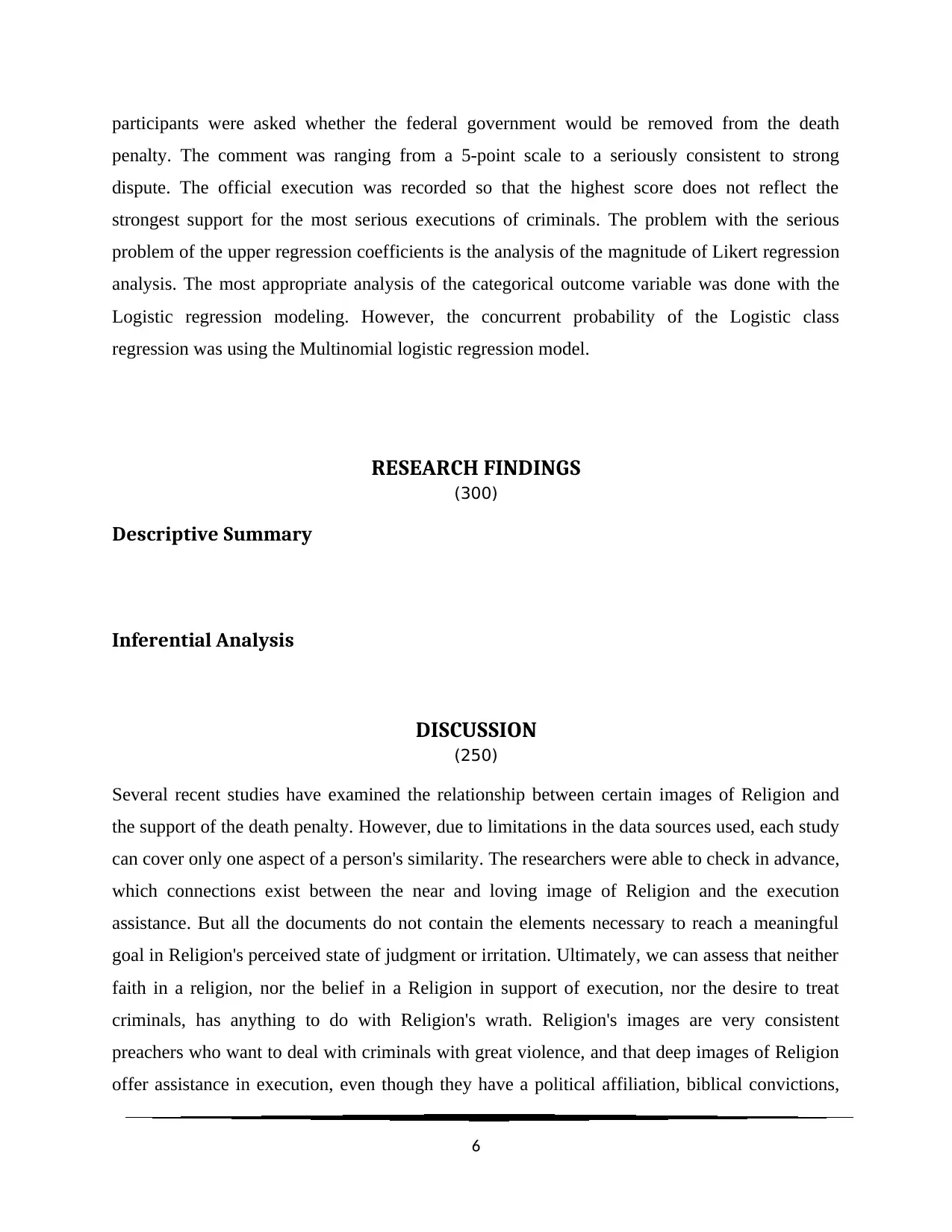
participants were asked whether the federal government would be removed from the death
penalty. The comment was ranging from a 5-point scale to a seriously consistent to strong
dispute. The official execution was recorded so that the highest score does not reflect the
strongest support for the most serious executions of criminals. The problem with the serious
problem of the upper regression coefficients is the analysis of the magnitude of Likert regression
analysis. The most appropriate analysis of the categorical outcome variable was done with the
Logistic regression modeling. However, the concurrent probability of the Logistic class
regression was using the Multinomial logistic regression model.
RESEARCH FINDINGS
(300)
Descriptive Summary
Inferential Analysis
DISCUSSION
(250)
Several recent studies have examined the relationship between certain images of Religion and
the support of the death penalty. However, due to limitations in the data sources used, each study
can cover only one aspect of a person's similarity. The researchers were able to check in advance,
which connections exist between the near and loving image of Religion and the execution
assistance. But all the documents do not contain the elements necessary to reach a meaningful
goal in Religion's perceived state of judgment or irritation. Ultimately, we can assess that neither
faith in a religion, nor the belief in a Religion in support of execution, nor the desire to treat
criminals, has anything to do with Religion's wrath. Religion's images are very consistent
preachers who want to deal with criminals with great violence, and that deep images of Religion
offer assistance in execution, even though they have a political affiliation, biblical convictions,
6
penalty. The comment was ranging from a 5-point scale to a seriously consistent to strong
dispute. The official execution was recorded so that the highest score does not reflect the
strongest support for the most serious executions of criminals. The problem with the serious
problem of the upper regression coefficients is the analysis of the magnitude of Likert regression
analysis. The most appropriate analysis of the categorical outcome variable was done with the
Logistic regression modeling. However, the concurrent probability of the Logistic class
regression was using the Multinomial logistic regression model.
RESEARCH FINDINGS
(300)
Descriptive Summary
Inferential Analysis
DISCUSSION
(250)
Several recent studies have examined the relationship between certain images of Religion and
the support of the death penalty. However, due to limitations in the data sources used, each study
can cover only one aspect of a person's similarity. The researchers were able to check in advance,
which connections exist between the near and loving image of Religion and the execution
assistance. But all the documents do not contain the elements necessary to reach a meaningful
goal in Religion's perceived state of judgment or irritation. Ultimately, we can assess that neither
faith in a religion, nor the belief in a Religion in support of execution, nor the desire to treat
criminals, has anything to do with Religion's wrath. Religion's images are very consistent
preachers who want to deal with criminals with great violence, and that deep images of Religion
offer assistance in execution, even though they have a political affiliation, biblical convictions,
6
⊘ This is a preview!⊘
Do you want full access?
Subscribe today to unlock all pages.

Trusted by 1+ million students worldwide
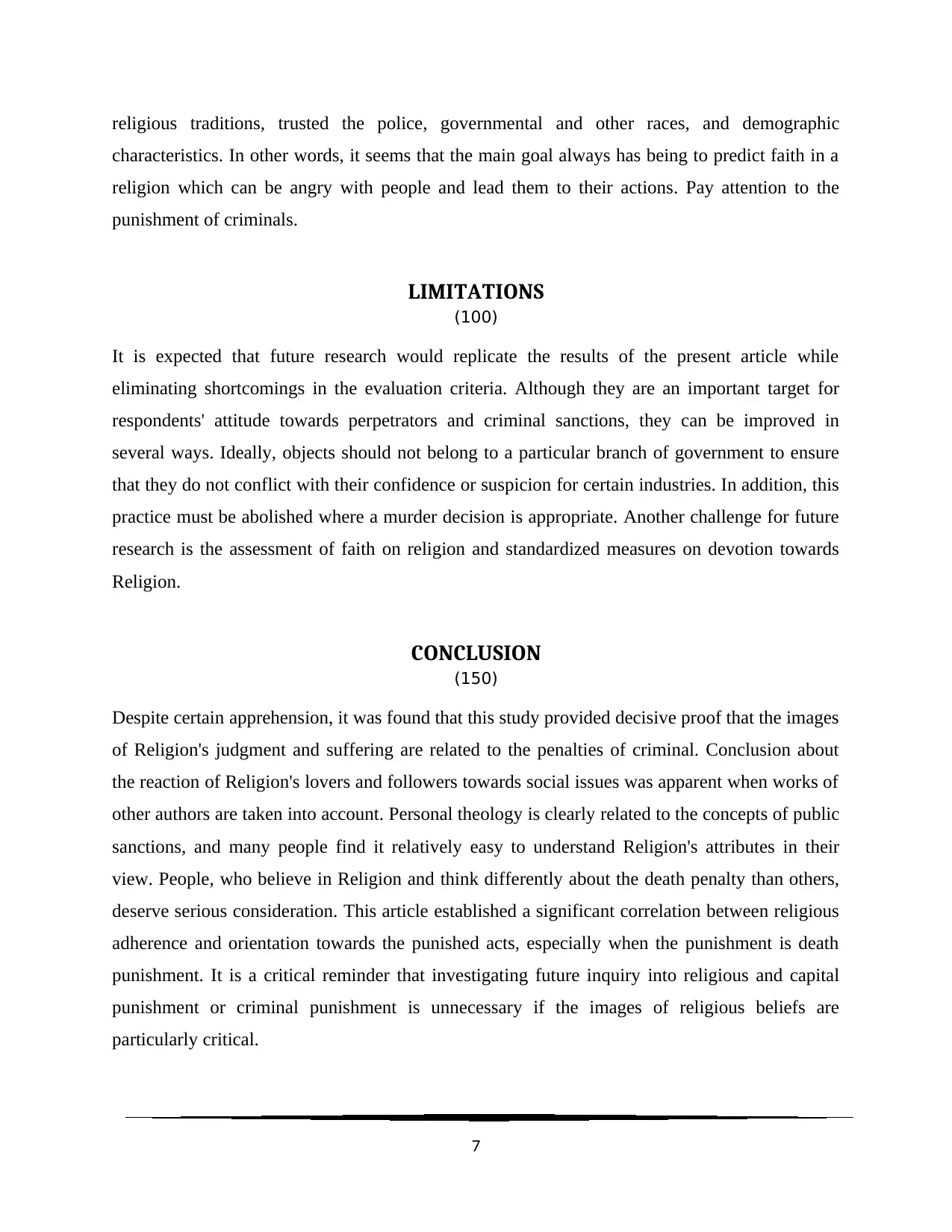
religious traditions, trusted the police, governmental and other races, and demographic
characteristics. In other words, it seems that the main goal always has being to predict faith in a
religion which can be angry with people and lead them to their actions. Pay attention to the
punishment of criminals.
LIMITATIONS
(100)
It is expected that future research would replicate the results of the present article while
eliminating shortcomings in the evaluation criteria. Although they are an important target for
respondents' attitude towards perpetrators and criminal sanctions, they can be improved in
several ways. Ideally, objects should not belong to a particular branch of government to ensure
that they do not conflict with their confidence or suspicion for certain industries. In addition, this
practice must be abolished where a murder decision is appropriate. Another challenge for future
research is the assessment of faith on religion and standardized measures on devotion towards
Religion.
CONCLUSION
(150)
Despite certain apprehension, it was found that this study provided decisive proof that the images
of Religion's judgment and suffering are related to the penalties of criminal. Conclusion about
the reaction of Religion's lovers and followers towards social issues was apparent when works of
other authors are taken into account. Personal theology is clearly related to the concepts of public
sanctions, and many people find it relatively easy to understand Religion's attributes in their
view. People, who believe in Religion and think differently about the death penalty than others,
deserve serious consideration. This article established a significant correlation between religious
adherence and orientation towards the punished acts, especially when the punishment is death
punishment. It is a critical reminder that investigating future inquiry into religious and capital
punishment or criminal punishment is unnecessary if the images of religious beliefs are
particularly critical.
7
characteristics. In other words, it seems that the main goal always has being to predict faith in a
religion which can be angry with people and lead them to their actions. Pay attention to the
punishment of criminals.
LIMITATIONS
(100)
It is expected that future research would replicate the results of the present article while
eliminating shortcomings in the evaluation criteria. Although they are an important target for
respondents' attitude towards perpetrators and criminal sanctions, they can be improved in
several ways. Ideally, objects should not belong to a particular branch of government to ensure
that they do not conflict with their confidence or suspicion for certain industries. In addition, this
practice must be abolished where a murder decision is appropriate. Another challenge for future
research is the assessment of faith on religion and standardized measures on devotion towards
Religion.
CONCLUSION
(150)
Despite certain apprehension, it was found that this study provided decisive proof that the images
of Religion's judgment and suffering are related to the penalties of criminal. Conclusion about
the reaction of Religion's lovers and followers towards social issues was apparent when works of
other authors are taken into account. Personal theology is clearly related to the concepts of public
sanctions, and many people find it relatively easy to understand Religion's attributes in their
view. People, who believe in Religion and think differently about the death penalty than others,
deserve serious consideration. This article established a significant correlation between religious
adherence and orientation towards the punished acts, especially when the punishment is death
punishment. It is a critical reminder that investigating future inquiry into religious and capital
punishment or criminal punishment is unnecessary if the images of religious beliefs are
particularly critical.
7
Paraphrase This Document
Need a fresh take? Get an instant paraphrase of this document with our AI Paraphraser

8
1 out of 8
Related Documents
Your All-in-One AI-Powered Toolkit for Academic Success.
+13062052269
info@desklib.com
Available 24*7 on WhatsApp / Email
![[object Object]](/_next/static/media/star-bottom.7253800d.svg)
Unlock your academic potential
Copyright © 2020–2025 A2Z Services. All Rights Reserved. Developed and managed by ZUCOL.



